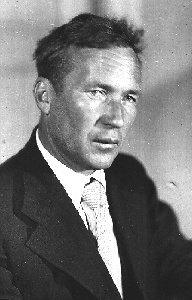TURBULENCE

A.N. Kolmogorov
(Our Master)
A satisfactory theory of the small scale statistics of fully
developed turbulence is one of the most challenging problem
in theoretical physics with clear interest for many applicative
issues, e.g. geophysics and engineering.
The traditional description of turbulence
(as summarized in the monograph by A.S. Monin and A.M. Yaglom
Statistical Fluid Mechanics Vol. 1 and 2, MIT Press (1971,1975))
employs statistical methods, truncation schemes in the form of
approximate closure theories and phenomenological models
(e.g. Kolmogorov's theories of 1941 and 1962).
A complementary point of view
is to regard the Navier-Stokes equations, or other partial
differential equations describing turbulent systems,
as a deterministic dynamical system and to regard the turbulence
as a manifestation of deterministic chaos.
It was surprizing that concepts from low dimensional dynamical
systems, even seemingly abstract mathematical devices like iterated
maps, could be used to describe systems as complicated as unsteady
fluids. For fluids under severe constraints, i.e. the
experiments on Rayleigh-B\'enard convection in small cells, the
success was undisputed. For the understanding of turbulence,
however, the success has been more limited. Turbulence, which
implies spatial as well as temporal disorder, cannot be reduced to a
low-dimensional system, and thus a large part of the theory of
dynamical systems, in particular regarding bifurcation structures and
symbolic dynamics, becomes basically inapplicable.
Moreover in the case of fully developed turbulence the direct
simulation of the Navier-Stokes equations is prohibitively difficult
due to the large range of relevant length scales, it is thus important
to introdoce and study simplified models.
It is important to note that the dynamical models employed to describe
turbulent states are not low-dimensional. In flows with high Reynolds
numbers or in chaotic systems of large spatial extent, the number of
relevant degrees of freedom is very large, and our primary interest is
to explore properties that are well-defined in the thermodynamic
limit, where the system size (or Reynolds number) becomes
very large.
Some of the main concepts and characteristics of this approach to
turbulence are:
- 1) The use of quantifiers of chaotic dynamics, like Lyapunov exponents, entropies and
dimensions. These concepts provide a very precise determination of
e.g. the onset of turbulence, and an understanding of the interplay
between temporal chaos and spatial scales. In addition they provide
information about the propagation of information and disturbances.
- 2) The use of the geometrical description of (multi)fractal
objects, i.e. concepts borrowed from the thermodynamical
formalism for dynamical systems. These concepts provide a
framework for understanding subtle statistical properties like
intermittency and allows detailed comparison to experimental data.
- 3) The numerical study of simplified dynamical models of
turbulence, like shell models, coupled maps or amplitude equations.
Here it is important to consider these systems as non-linear
dynamical systems in their full complexity, for which the more
traditional study of stationary and periodic states and their stability is
only the first step.
- 4) The numerical construction of signals mimicking the real
turbulence. This is particularly important both for the comparison of
theorethical models with experimental data and the study of lagrangian properties in synthetic turbulence.
- 5) The use of Direct Numerical Simulations of Navier-Stokes equation
in both two and three dimensions at high resolution. This research
is partially done on parallel supercomputers thanks to grants with
Cineca.

